Managing for Sustainability Report: BHP Billiton Analysis, MAN2610
VerifiedAdded on 2023/06/04
|13
|3120
|420
Report
AI Summary
This report examines the sustainability practices of BHP Billiton within the mining sector, focusing on environmental, social, and economic dimensions. It explores the concept of sustainable development, emphasizing the importance of balancing present resource utilization with future needs. The report analyzes BHP Billiton's performance, highlighting challenges such as integrating environmental and economic activities, and the impacts of climate change. It discusses the company's policies, including transparency initiatives and community engagement programs. A critical analysis of BHP Billiton's approach is provided, along with recommendations for improvement, such as the need for clear environmental benchmarks and a stronger focus on socio-economic factors. The report concludes by emphasizing the importance of continuous efforts towards sustainable development in the mining industry, including the need for cost-benefit decisions that cover all three aspects of sustainability and proactive thinking on climate change.
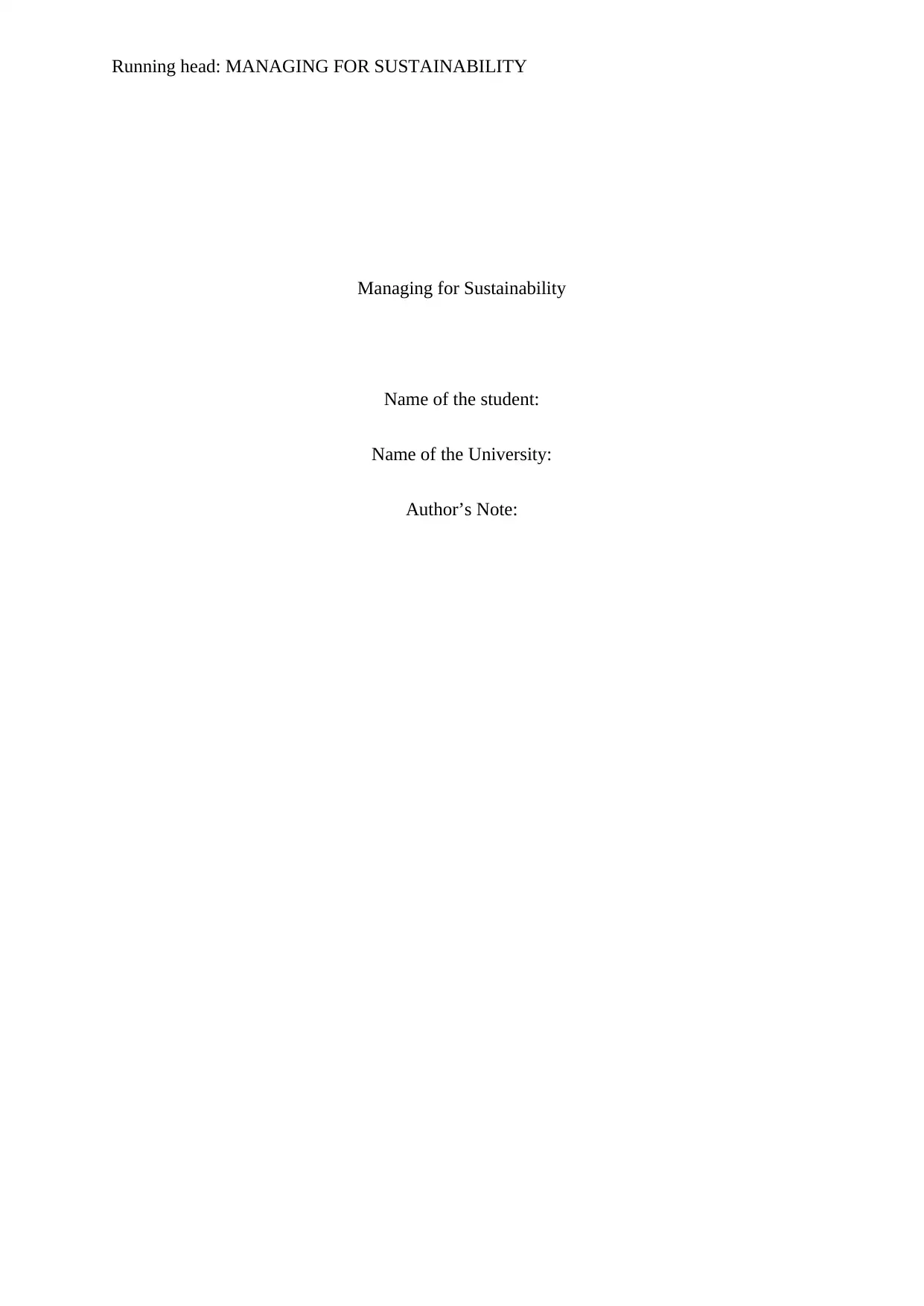
Running head: MANAGING FOR SUSTAINABILITY
Managing for Sustainability
Name of the student:
Name of the University:
Author’s Note:
Managing for Sustainability
Name of the student:
Name of the University:
Author’s Note:
Paraphrase This Document
Need a fresh take? Get an instant paraphrase of this document with our AI Paraphraser
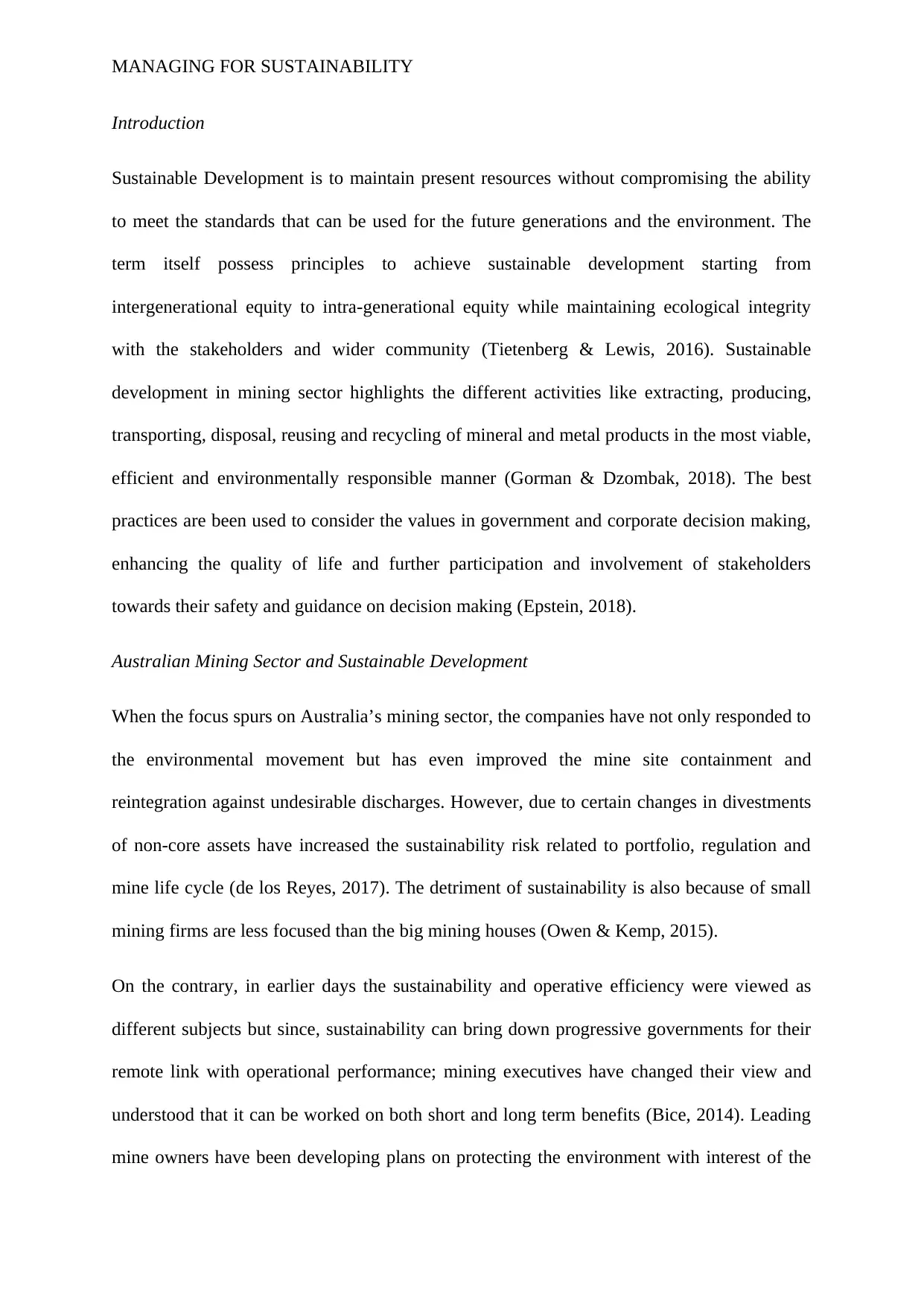
MANAGING FOR SUSTAINABILITY
Introduction
Sustainable Development is to maintain present resources without compromising the ability
to meet the standards that can be used for the future generations and the environment. The
term itself possess principles to achieve sustainable development starting from
intergenerational equity to intra-generational equity while maintaining ecological integrity
with the stakeholders and wider community (Tietenberg & Lewis, 2016). Sustainable
development in mining sector highlights the different activities like extracting, producing,
transporting, disposal, reusing and recycling of mineral and metal products in the most viable,
efficient and environmentally responsible manner (Gorman & Dzombak, 2018). The best
practices are been used to consider the values in government and corporate decision making,
enhancing the quality of life and further participation and involvement of stakeholders
towards their safety and guidance on decision making (Epstein, 2018).
Australian Mining Sector and Sustainable Development
When the focus spurs on Australia’s mining sector, the companies have not only responded to
the environmental movement but has even improved the mine site containment and
reintegration against undesirable discharges. However, due to certain changes in divestments
of non-core assets have increased the sustainability risk related to portfolio, regulation and
mine life cycle (de los Reyes, 2017). The detriment of sustainability is also because of small
mining firms are less focused than the big mining houses (Owen & Kemp, 2015).
On the contrary, in earlier days the sustainability and operative efficiency were viewed as
different subjects but since, sustainability can bring down progressive governments for their
remote link with operational performance; mining executives have changed their view and
understood that it can be worked on both short and long term benefits (Bice, 2014). Leading
mine owners have been developing plans on protecting the environment with interest of the
Introduction
Sustainable Development is to maintain present resources without compromising the ability
to meet the standards that can be used for the future generations and the environment. The
term itself possess principles to achieve sustainable development starting from
intergenerational equity to intra-generational equity while maintaining ecological integrity
with the stakeholders and wider community (Tietenberg & Lewis, 2016). Sustainable
development in mining sector highlights the different activities like extracting, producing,
transporting, disposal, reusing and recycling of mineral and metal products in the most viable,
efficient and environmentally responsible manner (Gorman & Dzombak, 2018). The best
practices are been used to consider the values in government and corporate decision making,
enhancing the quality of life and further participation and involvement of stakeholders
towards their safety and guidance on decision making (Epstein, 2018).
Australian Mining Sector and Sustainable Development
When the focus spurs on Australia’s mining sector, the companies have not only responded to
the environmental movement but has even improved the mine site containment and
reintegration against undesirable discharges. However, due to certain changes in divestments
of non-core assets have increased the sustainability risk related to portfolio, regulation and
mine life cycle (de los Reyes, 2017). The detriment of sustainability is also because of small
mining firms are less focused than the big mining houses (Owen & Kemp, 2015).
On the contrary, in earlier days the sustainability and operative efficiency were viewed as
different subjects but since, sustainability can bring down progressive governments for their
remote link with operational performance; mining executives have changed their view and
understood that it can be worked on both short and long term benefits (Bice, 2014). Leading
mine owners have been developing plans on protecting the environment with interest of the

MANAGING FOR SUSTAINABILITY
people while focusing on mine’s life cycle (Corder, 2017). Basically, to focus on three
aspects of sustainability issues – economic, social and environmental.
Figure 1: Three aspects of Sustainability
Source: (atkearney.com.au., 2016)
The significance of choosing mining sector is because contribution to Gross Domestic
Product (GDP) has been 8.5% in 2015 and contributes to 2% of the workforce as it is majorly
a capital intensive sector. Also, because of low population density area, Australia has an
advantage in geological endowment with mineral resources making it favourable for long
term sustainability.
Significance of choosing BHP Billiton
In mining sector, company like BHP Billiton can help in analysing the sustainability on its 3
aspects. This company is world wide known for its diversified natural resources whether its
in the sector of oil or gas or major commodities like iron ore, energy coal, aluminium, copper
and so on (bhp.com, 208). Nevertheless, being significant in the field of energy of being an
exporter, producer or the consumer, the company aims to reduce carbon emission rate with
waster usage, and wishes to commit to communities with the principle of health and safety
people while focusing on mine’s life cycle (Corder, 2017). Basically, to focus on three
aspects of sustainability issues – economic, social and environmental.
Figure 1: Three aspects of Sustainability
Source: (atkearney.com.au., 2016)
The significance of choosing mining sector is because contribution to Gross Domestic
Product (GDP) has been 8.5% in 2015 and contributes to 2% of the workforce as it is majorly
a capital intensive sector. Also, because of low population density area, Australia has an
advantage in geological endowment with mineral resources making it favourable for long
term sustainability.
Significance of choosing BHP Billiton
In mining sector, company like BHP Billiton can help in analysing the sustainability on its 3
aspects. This company is world wide known for its diversified natural resources whether its
in the sector of oil or gas or major commodities like iron ore, energy coal, aluminium, copper
and so on (bhp.com, 208). Nevertheless, being significant in the field of energy of being an
exporter, producer or the consumer, the company aims to reduce carbon emission rate with
waster usage, and wishes to commit to communities with the principle of health and safety
⊘ This is a preview!⊘
Do you want full access?
Subscribe today to unlock all pages.

Trusted by 1+ million students worldwide
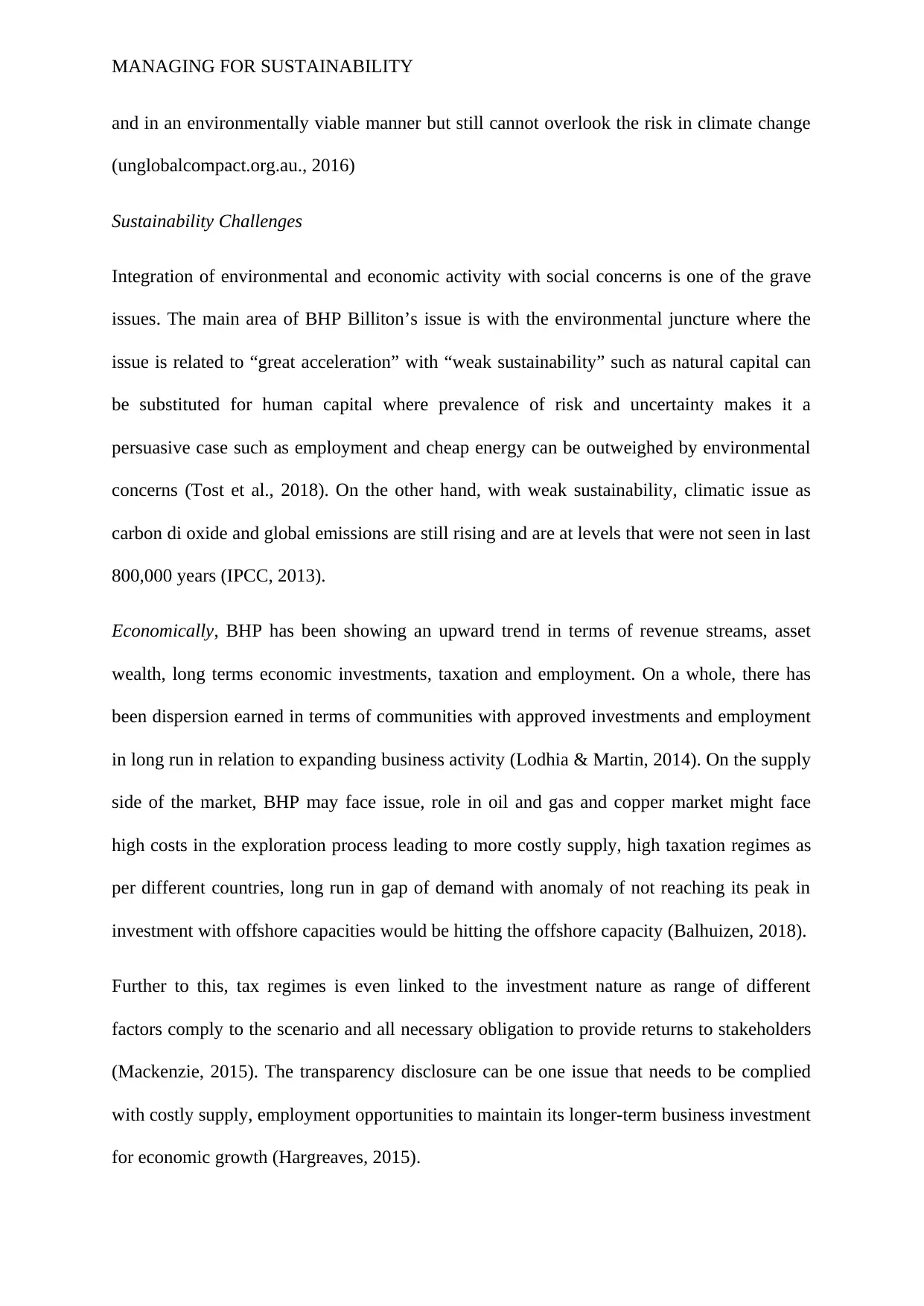
MANAGING FOR SUSTAINABILITY
and in an environmentally viable manner but still cannot overlook the risk in climate change
(unglobalcompact.org.au., 2016)
Sustainability Challenges
Integration of environmental and economic activity with social concerns is one of the grave
issues. The main area of BHP Billiton’s issue is with the environmental juncture where the
issue is related to “great acceleration” with “weak sustainability” such as natural capital can
be substituted for human capital where prevalence of risk and uncertainty makes it a
persuasive case such as employment and cheap energy can be outweighed by environmental
concerns (Tost et al., 2018). On the other hand, with weak sustainability, climatic issue as
carbon di oxide and global emissions are still rising and are at levels that were not seen in last
800,000 years (IPCC, 2013).
Economically, BHP has been showing an upward trend in terms of revenue streams, asset
wealth, long terms economic investments, taxation and employment. On a whole, there has
been dispersion earned in terms of communities with approved investments and employment
in long run in relation to expanding business activity (Lodhia & Martin, 2014). On the supply
side of the market, BHP may face issue, role in oil and gas and copper market might face
high costs in the exploration process leading to more costly supply, high taxation regimes as
per different countries, long run in gap of demand with anomaly of not reaching its peak in
investment with offshore capacities would be hitting the offshore capacity (Balhuizen, 2018).
Further to this, tax regimes is even linked to the investment nature as range of different
factors comply to the scenario and all necessary obligation to provide returns to stakeholders
(Mackenzie, 2015). The transparency disclosure can be one issue that needs to be complied
with costly supply, employment opportunities to maintain its longer-term business investment
for economic growth (Hargreaves, 2015).
and in an environmentally viable manner but still cannot overlook the risk in climate change
(unglobalcompact.org.au., 2016)
Sustainability Challenges
Integration of environmental and economic activity with social concerns is one of the grave
issues. The main area of BHP Billiton’s issue is with the environmental juncture where the
issue is related to “great acceleration” with “weak sustainability” such as natural capital can
be substituted for human capital where prevalence of risk and uncertainty makes it a
persuasive case such as employment and cheap energy can be outweighed by environmental
concerns (Tost et al., 2018). On the other hand, with weak sustainability, climatic issue as
carbon di oxide and global emissions are still rising and are at levels that were not seen in last
800,000 years (IPCC, 2013).
Economically, BHP has been showing an upward trend in terms of revenue streams, asset
wealth, long terms economic investments, taxation and employment. On a whole, there has
been dispersion earned in terms of communities with approved investments and employment
in long run in relation to expanding business activity (Lodhia & Martin, 2014). On the supply
side of the market, BHP may face issue, role in oil and gas and copper market might face
high costs in the exploration process leading to more costly supply, high taxation regimes as
per different countries, long run in gap of demand with anomaly of not reaching its peak in
investment with offshore capacities would be hitting the offshore capacity (Balhuizen, 2018).
Further to this, tax regimes is even linked to the investment nature as range of different
factors comply to the scenario and all necessary obligation to provide returns to stakeholders
(Mackenzie, 2015). The transparency disclosure can be one issue that needs to be complied
with costly supply, employment opportunities to maintain its longer-term business investment
for economic growth (Hargreaves, 2015).
Paraphrase This Document
Need a fresh take? Get an instant paraphrase of this document with our AI Paraphraser
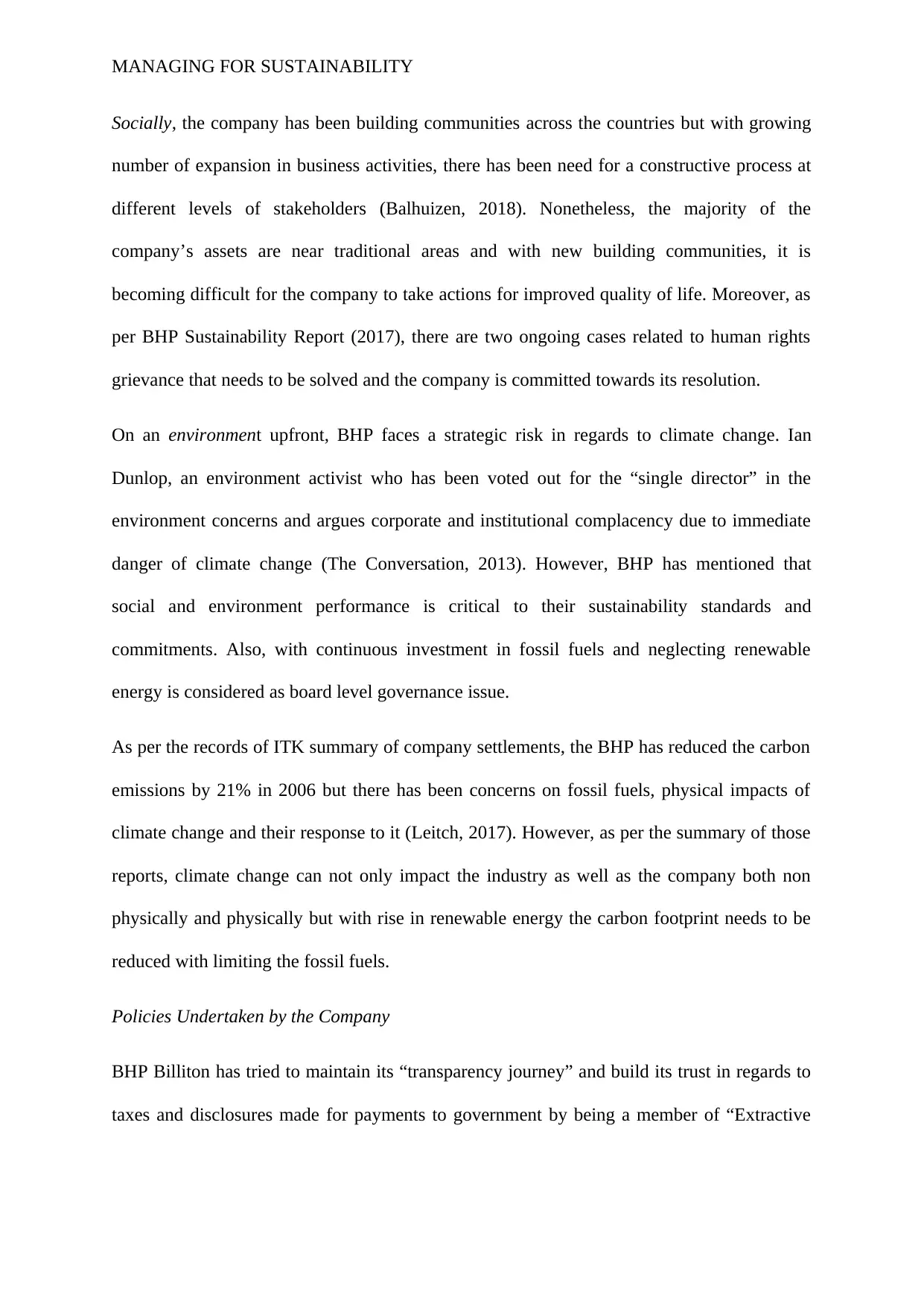
MANAGING FOR SUSTAINABILITY
Socially, the company has been building communities across the countries but with growing
number of expansion in business activities, there has been need for a constructive process at
different levels of stakeholders (Balhuizen, 2018). Nonetheless, the majority of the
company’s assets are near traditional areas and with new building communities, it is
becoming difficult for the company to take actions for improved quality of life. Moreover, as
per BHP Sustainability Report (2017), there are two ongoing cases related to human rights
grievance that needs to be solved and the company is committed towards its resolution.
On an environment upfront, BHP faces a strategic risk in regards to climate change. Ian
Dunlop, an environment activist who has been voted out for the “single director” in the
environment concerns and argues corporate and institutional complacency due to immediate
danger of climate change (The Conversation, 2013). However, BHP has mentioned that
social and environment performance is critical to their sustainability standards and
commitments. Also, with continuous investment in fossil fuels and neglecting renewable
energy is considered as board level governance issue.
As per the records of ITK summary of company settlements, the BHP has reduced the carbon
emissions by 21% in 2006 but there has been concerns on fossil fuels, physical impacts of
climate change and their response to it (Leitch, 2017). However, as per the summary of those
reports, climate change can not only impact the industry as well as the company both non
physically and physically but with rise in renewable energy the carbon footprint needs to be
reduced with limiting the fossil fuels.
Policies Undertaken by the Company
BHP Billiton has tried to maintain its “transparency journey” and build its trust in regards to
taxes and disclosures made for payments to government by being a member of “Extractive
Socially, the company has been building communities across the countries but with growing
number of expansion in business activities, there has been need for a constructive process at
different levels of stakeholders (Balhuizen, 2018). Nonetheless, the majority of the
company’s assets are near traditional areas and with new building communities, it is
becoming difficult for the company to take actions for improved quality of life. Moreover, as
per BHP Sustainability Report (2017), there are two ongoing cases related to human rights
grievance that needs to be solved and the company is committed towards its resolution.
On an environment upfront, BHP faces a strategic risk in regards to climate change. Ian
Dunlop, an environment activist who has been voted out for the “single director” in the
environment concerns and argues corporate and institutional complacency due to immediate
danger of climate change (The Conversation, 2013). However, BHP has mentioned that
social and environment performance is critical to their sustainability standards and
commitments. Also, with continuous investment in fossil fuels and neglecting renewable
energy is considered as board level governance issue.
As per the records of ITK summary of company settlements, the BHP has reduced the carbon
emissions by 21% in 2006 but there has been concerns on fossil fuels, physical impacts of
climate change and their response to it (Leitch, 2017). However, as per the summary of those
reports, climate change can not only impact the industry as well as the company both non
physically and physically but with rise in renewable energy the carbon footprint needs to be
reduced with limiting the fossil fuels.
Policies Undertaken by the Company
BHP Billiton has tried to maintain its “transparency journey” and build its trust in regards to
taxes and disclosures made for payments to government by being a member of “Extractive
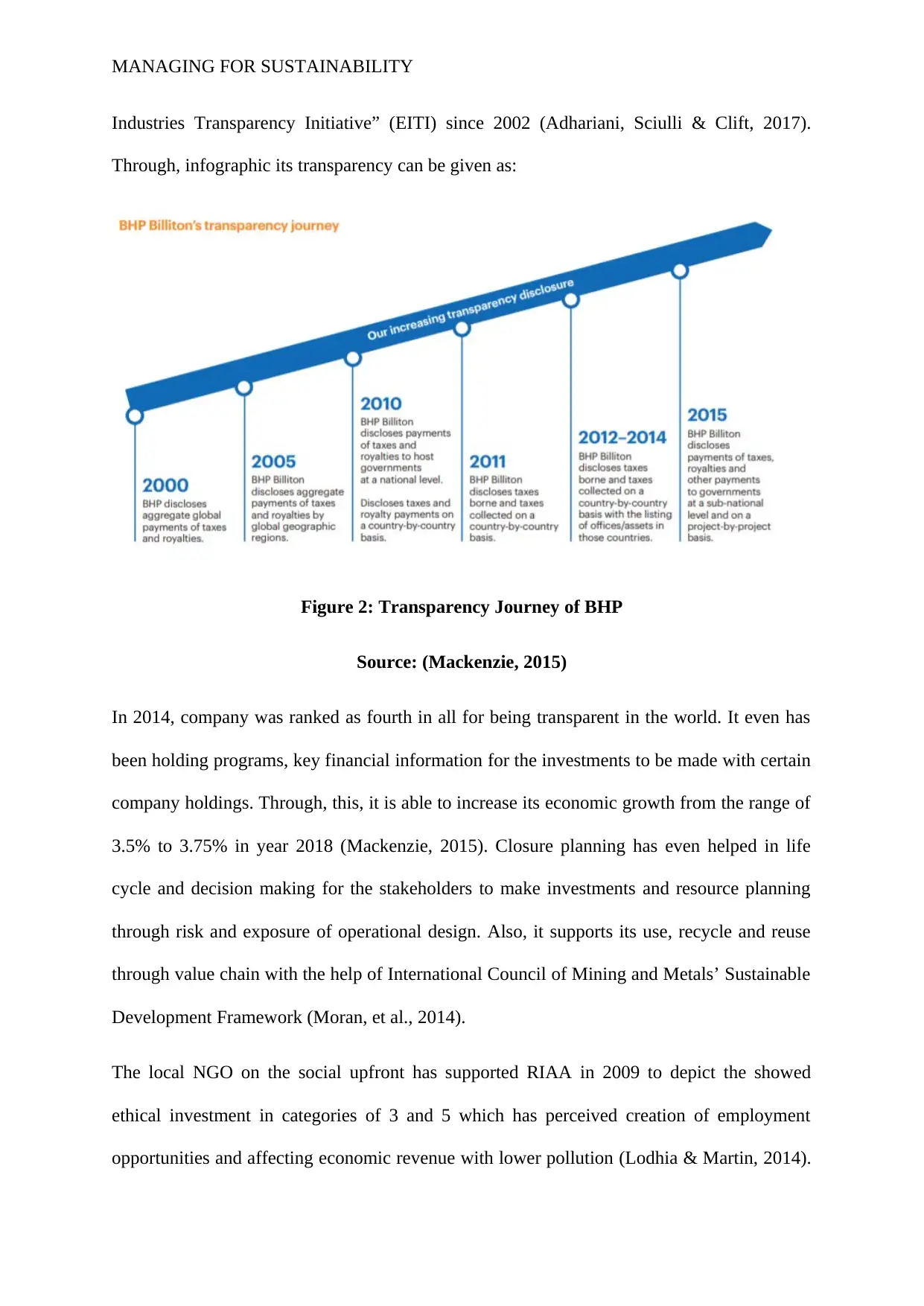
MANAGING FOR SUSTAINABILITY
Industries Transparency Initiative” (EITI) since 2002 (Adhariani, Sciulli & Clift, 2017).
Through, infographic its transparency can be given as:
Figure 2: Transparency Journey of BHP
Source: (Mackenzie, 2015)
In 2014, company was ranked as fourth in all for being transparent in the world. It even has
been holding programs, key financial information for the investments to be made with certain
company holdings. Through, this, it is able to increase its economic growth from the range of
3.5% to 3.75% in year 2018 (Mackenzie, 2015). Closure planning has even helped in life
cycle and decision making for the stakeholders to make investments and resource planning
through risk and exposure of operational design. Also, it supports its use, recycle and reuse
through value chain with the help of International Council of Mining and Metals’ Sustainable
Development Framework (Moran, et al., 2014).
The local NGO on the social upfront has supported RIAA in 2009 to depict the showed
ethical investment in categories of 3 and 5 which has perceived creation of employment
opportunities and affecting economic revenue with lower pollution (Lodhia & Martin, 2014).
Industries Transparency Initiative” (EITI) since 2002 (Adhariani, Sciulli & Clift, 2017).
Through, infographic its transparency can be given as:
Figure 2: Transparency Journey of BHP
Source: (Mackenzie, 2015)
In 2014, company was ranked as fourth in all for being transparent in the world. It even has
been holding programs, key financial information for the investments to be made with certain
company holdings. Through, this, it is able to increase its economic growth from the range of
3.5% to 3.75% in year 2018 (Mackenzie, 2015). Closure planning has even helped in life
cycle and decision making for the stakeholders to make investments and resource planning
through risk and exposure of operational design. Also, it supports its use, recycle and reuse
through value chain with the help of International Council of Mining and Metals’ Sustainable
Development Framework (Moran, et al., 2014).
The local NGO on the social upfront has supported RIAA in 2009 to depict the showed
ethical investment in categories of 3 and 5 which has perceived creation of employment
opportunities and affecting economic revenue with lower pollution (Lodhia & Martin, 2014).
⊘ This is a preview!⊘
Do you want full access?
Subscribe today to unlock all pages.

Trusted by 1+ million students worldwide
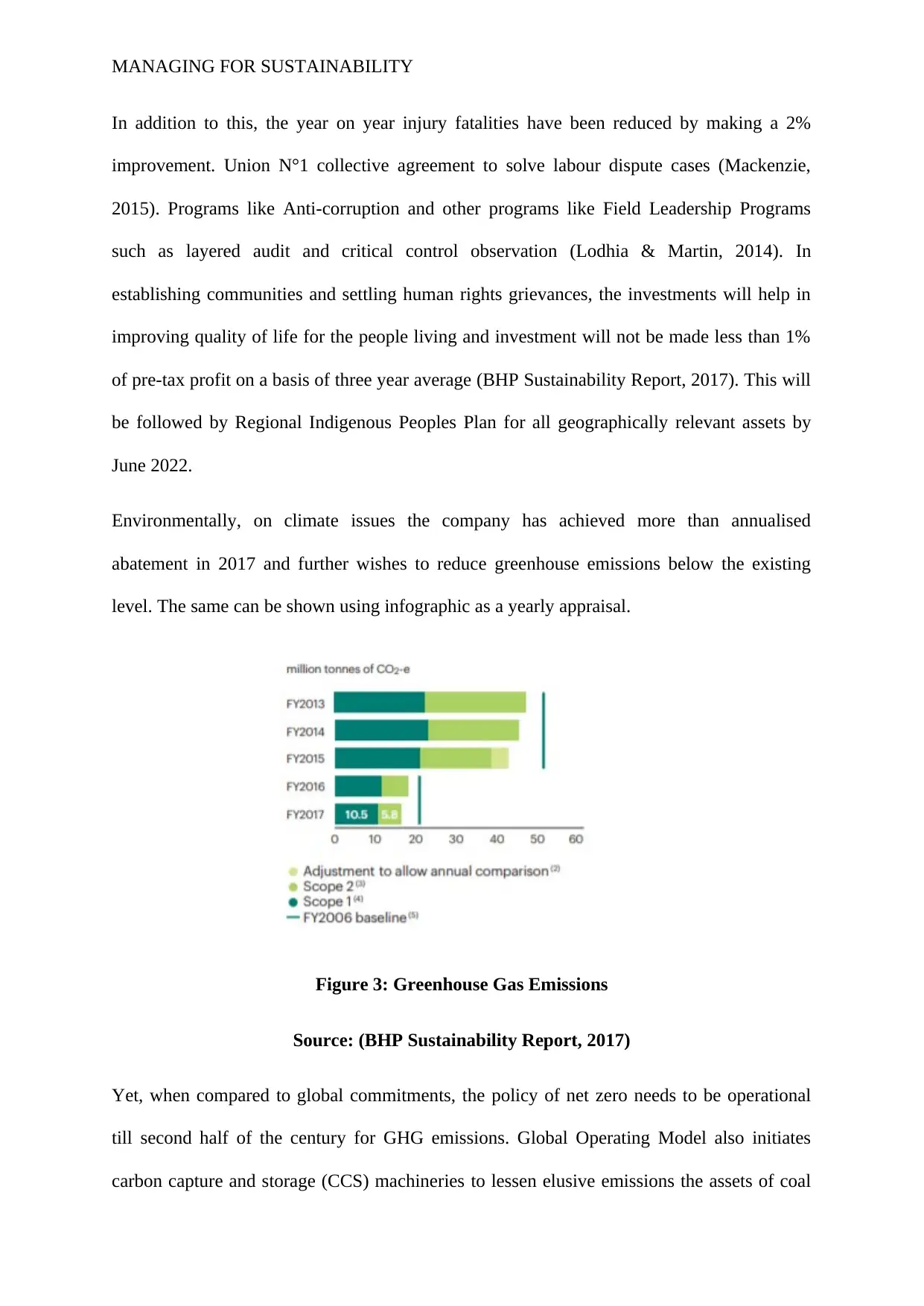
MANAGING FOR SUSTAINABILITY
In addition to this, the year on year injury fatalities have been reduced by making a 2%
improvement. Union N°1 collective agreement to solve labour dispute cases (Mackenzie,
2015). Programs like Anti-corruption and other programs like Field Leadership Programs
such as layered audit and critical control observation (Lodhia & Martin, 2014). In
establishing communities and settling human rights grievances, the investments will help in
improving quality of life for the people living and investment will not be made less than 1%
of pre-tax profit on a basis of three year average (BHP Sustainability Report, 2017). This will
be followed by Regional Indigenous Peoples Plan for all geographically relevant assets by
June 2022.
Environmentally, on climate issues the company has achieved more than annualised
abatement in 2017 and further wishes to reduce greenhouse emissions below the existing
level. The same can be shown using infographic as a yearly appraisal.
Figure 3: Greenhouse Gas Emissions
Source: (BHP Sustainability Report, 2017)
Yet, when compared to global commitments, the policy of net zero needs to be operational
till second half of the century for GHG emissions. Global Operating Model also initiates
carbon capture and storage (CCS) machineries to lessen elusive emissions the assets of coal
In addition to this, the year on year injury fatalities have been reduced by making a 2%
improvement. Union N°1 collective agreement to solve labour dispute cases (Mackenzie,
2015). Programs like Anti-corruption and other programs like Field Leadership Programs
such as layered audit and critical control observation (Lodhia & Martin, 2014). In
establishing communities and settling human rights grievances, the investments will help in
improving quality of life for the people living and investment will not be made less than 1%
of pre-tax profit on a basis of three year average (BHP Sustainability Report, 2017). This will
be followed by Regional Indigenous Peoples Plan for all geographically relevant assets by
June 2022.
Environmentally, on climate issues the company has achieved more than annualised
abatement in 2017 and further wishes to reduce greenhouse emissions below the existing
level. The same can be shown using infographic as a yearly appraisal.
Figure 3: Greenhouse Gas Emissions
Source: (BHP Sustainability Report, 2017)
Yet, when compared to global commitments, the policy of net zero needs to be operational
till second half of the century for GHG emissions. Global Operating Model also initiates
carbon capture and storage (CCS) machineries to lessen elusive emissions the assets of coal
Paraphrase This Document
Need a fresh take? Get an instant paraphrase of this document with our AI Paraphraser
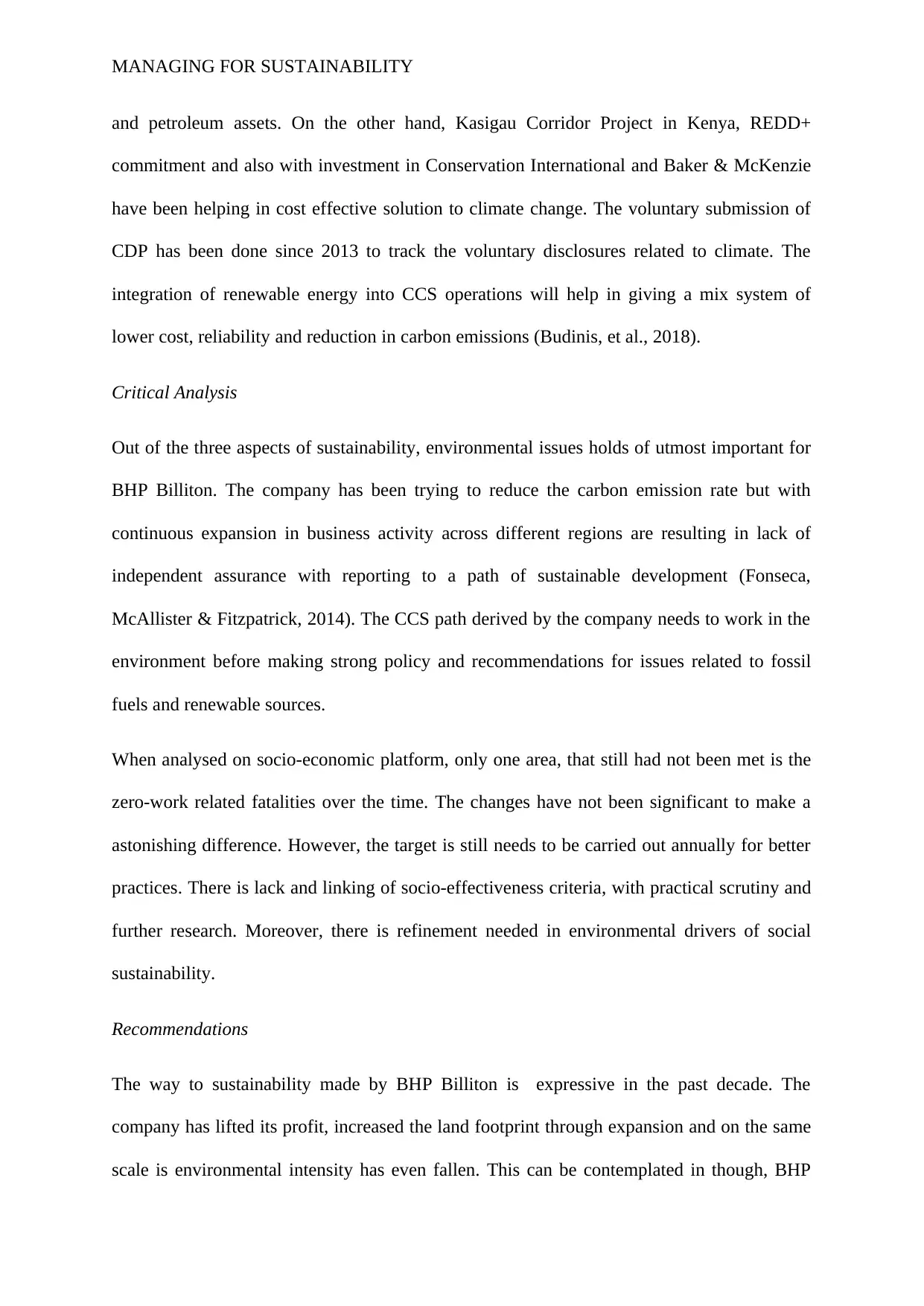
MANAGING FOR SUSTAINABILITY
and petroleum assets. On the other hand, Kasigau Corridor Project in Kenya, REDD+
commitment and also with investment in Conservation International and Baker & McKenzie
have been helping in cost effective solution to climate change. The voluntary submission of
CDP has been done since 2013 to track the voluntary disclosures related to climate. The
integration of renewable energy into CCS operations will help in giving a mix system of
lower cost, reliability and reduction in carbon emissions (Budinis, et al., 2018).
Critical Analysis
Out of the three aspects of sustainability, environmental issues holds of utmost important for
BHP Billiton. The company has been trying to reduce the carbon emission rate but with
continuous expansion in business activity across different regions are resulting in lack of
independent assurance with reporting to a path of sustainable development (Fonseca,
McAllister & Fitzpatrick, 2014). The CCS path derived by the company needs to work in the
environment before making strong policy and recommendations for issues related to fossil
fuels and renewable sources.
When analysed on socio-economic platform, only one area, that still had not been met is the
zero-work related fatalities over the time. The changes have not been significant to make a
astonishing difference. However, the target is still needs to be carried out annually for better
practices. There is lack and linking of socio-effectiveness criteria, with practical scrutiny and
further research. Moreover, there is refinement needed in environmental drivers of social
sustainability.
Recommendations
The way to sustainability made by BHP Billiton is expressive in the past decade. The
company has lifted its profit, increased the land footprint through expansion and on the same
scale is environmental intensity has even fallen. This can be contemplated in though, BHP
and petroleum assets. On the other hand, Kasigau Corridor Project in Kenya, REDD+
commitment and also with investment in Conservation International and Baker & McKenzie
have been helping in cost effective solution to climate change. The voluntary submission of
CDP has been done since 2013 to track the voluntary disclosures related to climate. The
integration of renewable energy into CCS operations will help in giving a mix system of
lower cost, reliability and reduction in carbon emissions (Budinis, et al., 2018).
Critical Analysis
Out of the three aspects of sustainability, environmental issues holds of utmost important for
BHP Billiton. The company has been trying to reduce the carbon emission rate but with
continuous expansion in business activity across different regions are resulting in lack of
independent assurance with reporting to a path of sustainable development (Fonseca,
McAllister & Fitzpatrick, 2014). The CCS path derived by the company needs to work in the
environment before making strong policy and recommendations for issues related to fossil
fuels and renewable sources.
When analysed on socio-economic platform, only one area, that still had not been met is the
zero-work related fatalities over the time. The changes have not been significant to make a
astonishing difference. However, the target is still needs to be carried out annually for better
practices. There is lack and linking of socio-effectiveness criteria, with practical scrutiny and
further research. Moreover, there is refinement needed in environmental drivers of social
sustainability.
Recommendations
The way to sustainability made by BHP Billiton is expressive in the past decade. The
company has lifted its profit, increased the land footprint through expansion and on the same
scale is environmental intensity has even fallen. This can be contemplated in though, BHP
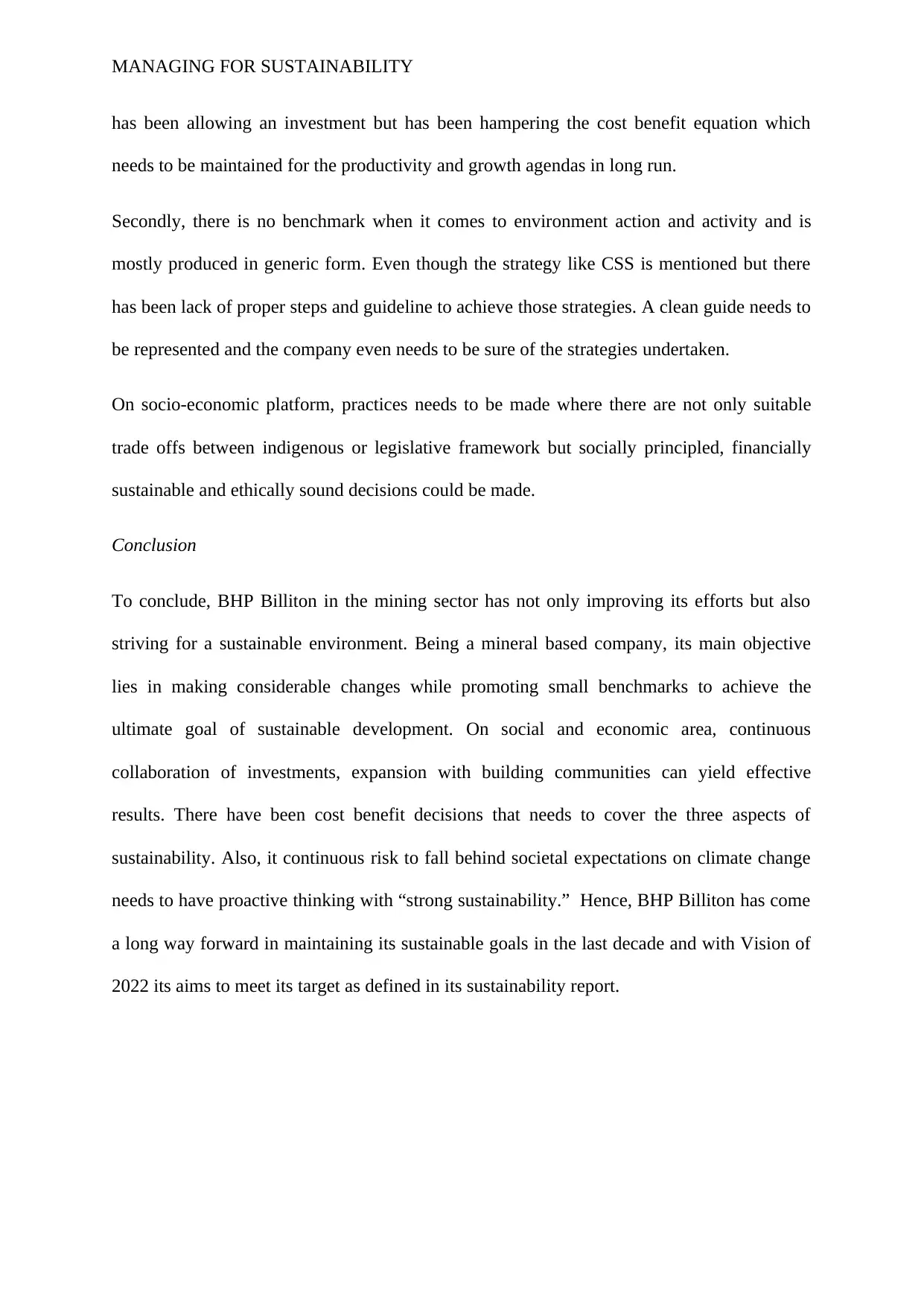
MANAGING FOR SUSTAINABILITY
has been allowing an investment but has been hampering the cost benefit equation which
needs to be maintained for the productivity and growth agendas in long run.
Secondly, there is no benchmark when it comes to environment action and activity and is
mostly produced in generic form. Even though the strategy like CSS is mentioned but there
has been lack of proper steps and guideline to achieve those strategies. A clean guide needs to
be represented and the company even needs to be sure of the strategies undertaken.
On socio-economic platform, practices needs to be made where there are not only suitable
trade offs between indigenous or legislative framework but socially principled, financially
sustainable and ethically sound decisions could be made.
Conclusion
To conclude, BHP Billiton in the mining sector has not only improving its efforts but also
striving for a sustainable environment. Being a mineral based company, its main objective
lies in making considerable changes while promoting small benchmarks to achieve the
ultimate goal of sustainable development. On social and economic area, continuous
collaboration of investments, expansion with building communities can yield effective
results. There have been cost benefit decisions that needs to cover the three aspects of
sustainability. Also, it continuous risk to fall behind societal expectations on climate change
needs to have proactive thinking with “strong sustainability.” Hence, BHP Billiton has come
a long way forward in maintaining its sustainable goals in the last decade and with Vision of
2022 its aims to meet its target as defined in its sustainability report.
has been allowing an investment but has been hampering the cost benefit equation which
needs to be maintained for the productivity and growth agendas in long run.
Secondly, there is no benchmark when it comes to environment action and activity and is
mostly produced in generic form. Even though the strategy like CSS is mentioned but there
has been lack of proper steps and guideline to achieve those strategies. A clean guide needs to
be represented and the company even needs to be sure of the strategies undertaken.
On socio-economic platform, practices needs to be made where there are not only suitable
trade offs between indigenous or legislative framework but socially principled, financially
sustainable and ethically sound decisions could be made.
Conclusion
To conclude, BHP Billiton in the mining sector has not only improving its efforts but also
striving for a sustainable environment. Being a mineral based company, its main objective
lies in making considerable changes while promoting small benchmarks to achieve the
ultimate goal of sustainable development. On social and economic area, continuous
collaboration of investments, expansion with building communities can yield effective
results. There have been cost benefit decisions that needs to cover the three aspects of
sustainability. Also, it continuous risk to fall behind societal expectations on climate change
needs to have proactive thinking with “strong sustainability.” Hence, BHP Billiton has come
a long way forward in maintaining its sustainable goals in the last decade and with Vision of
2022 its aims to meet its target as defined in its sustainability report.
⊘ This is a preview!⊘
Do you want full access?
Subscribe today to unlock all pages.

Trusted by 1+ million students worldwide
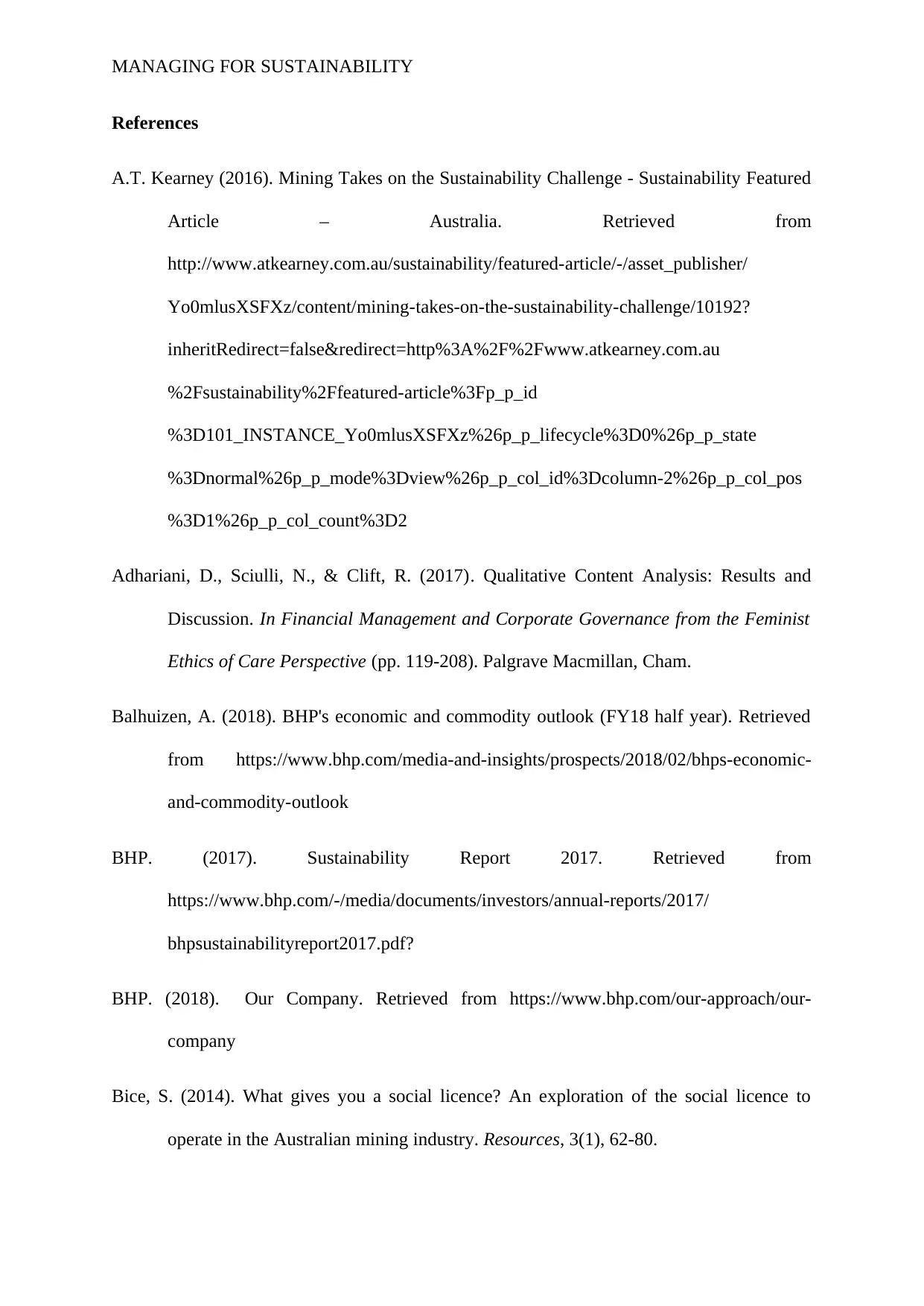
MANAGING FOR SUSTAINABILITY
References
A.T. Kearney (2016). Mining Takes on the Sustainability Challenge - Sustainability Featured
Article – Australia. Retrieved from
http://www.atkearney.com.au/sustainability/featured-article/-/asset_publisher/
Yo0mlusXSFXz/content/mining-takes-on-the-sustainability-challenge/10192?
inheritRedirect=false&redirect=http%3A%2F%2Fwww.atkearney.com.au
%2Fsustainability%2Ffeatured-article%3Fp_p_id
%3D101_INSTANCE_Yo0mlusXSFXz%26p_p_lifecycle%3D0%26p_p_state
%3Dnormal%26p_p_mode%3Dview%26p_p_col_id%3Dcolumn-2%26p_p_col_pos
%3D1%26p_p_col_count%3D2
Adhariani, D., Sciulli, N., & Clift, R. (2017). Qualitative Content Analysis: Results and
Discussion. In Financial Management and Corporate Governance from the Feminist
Ethics of Care Perspective (pp. 119-208). Palgrave Macmillan, Cham.
Balhuizen, A. (2018). BHP's economic and commodity outlook (FY18 half year). Retrieved
from https://www.bhp.com/media-and-insights/prospects/2018/02/bhps-economic-
and-commodity-outlook
BHP. (2017). Sustainability Report 2017. Retrieved from
https://www.bhp.com/-/media/documents/investors/annual-reports/2017/
bhpsustainabilityreport2017.pdf?
BHP. (2018). Our Company. Retrieved from https://www.bhp.com/our-approach/our-
company
Bice, S. (2014). What gives you a social licence? An exploration of the social licence to
operate in the Australian mining industry. Resources, 3(1), 62-80.
References
A.T. Kearney (2016). Mining Takes on the Sustainability Challenge - Sustainability Featured
Article – Australia. Retrieved from
http://www.atkearney.com.au/sustainability/featured-article/-/asset_publisher/
Yo0mlusXSFXz/content/mining-takes-on-the-sustainability-challenge/10192?
inheritRedirect=false&redirect=http%3A%2F%2Fwww.atkearney.com.au
%2Fsustainability%2Ffeatured-article%3Fp_p_id
%3D101_INSTANCE_Yo0mlusXSFXz%26p_p_lifecycle%3D0%26p_p_state
%3Dnormal%26p_p_mode%3Dview%26p_p_col_id%3Dcolumn-2%26p_p_col_pos
%3D1%26p_p_col_count%3D2
Adhariani, D., Sciulli, N., & Clift, R. (2017). Qualitative Content Analysis: Results and
Discussion. In Financial Management and Corporate Governance from the Feminist
Ethics of Care Perspective (pp. 119-208). Palgrave Macmillan, Cham.
Balhuizen, A. (2018). BHP's economic and commodity outlook (FY18 half year). Retrieved
from https://www.bhp.com/media-and-insights/prospects/2018/02/bhps-economic-
and-commodity-outlook
BHP. (2017). Sustainability Report 2017. Retrieved from
https://www.bhp.com/-/media/documents/investors/annual-reports/2017/
bhpsustainabilityreport2017.pdf?
BHP. (2018). Our Company. Retrieved from https://www.bhp.com/our-approach/our-
company
Bice, S. (2014). What gives you a social licence? An exploration of the social licence to
operate in the Australian mining industry. Resources, 3(1), 62-80.
Paraphrase This Document
Need a fresh take? Get an instant paraphrase of this document with our AI Paraphraser

MANAGING FOR SUSTAINABILITY
Budinis, S., Krevor, S., Mac Dowell, N., Brandon, N., & Hawkes, A. (2018). An assessment
of CCS costs, barriers and potential. Energy Strategy Reviews, 22, 61-81.
Corder, G. (2017). Mining and Sustainable Development. In Mining in the Asia-Pacific (pp.
253-269). Springer, Cham.
de los Reyes, J. A. (2017). Mining shareholder value: Institutional shareholders, transnational
corporations and the geography of gold mining. Geoforum, 84, 251-264.
Epstein, M. J. (2018). Making sustainability work: Best practices in managing and
measuring corporate social, environmental and economic impacts. Routledge.
Fonseca, A., McAllister, M. L., & Fitzpatrick, P. (2014). Sustainability reporting among
mining corporations: a constructive critique of the GRI approach. Journal of Cleaner
Production, 84, 70-83.
Global Compact Network Australia. (2016). BHP Billiton. Retrieved from
http://www.unglobalcompact.org.au/portfolio/bhp-billiton
Gorman, M. R., & Dzombak, D. A. (2018). A review of sustainable mining and resource
management: Transitioning from the life cycle of the mine to the life cycle of the
mineral. Resources, Conservation and Recycling, 137, 281-291.
Hargreaves, R. (2015). BHP Billiton plc Is Facing An Unprecedented Number Of Problems!.
Retrieved from https://www.fool.co.uk/investing/2015/04/14/bhp-billiton-plc-is-
facing-an-unprecedented-number-of-problems/
IPCC (Intergovernmental Panel on Climate Change), 2013. The Physical Science Basis.
Contribution of Working Group I to the Fifth Assessment Report of the
Intergovernmental Panel on Climate Change. Cambridge University Press,
Budinis, S., Krevor, S., Mac Dowell, N., Brandon, N., & Hawkes, A. (2018). An assessment
of CCS costs, barriers and potential. Energy Strategy Reviews, 22, 61-81.
Corder, G. (2017). Mining and Sustainable Development. In Mining in the Asia-Pacific (pp.
253-269). Springer, Cham.
de los Reyes, J. A. (2017). Mining shareholder value: Institutional shareholders, transnational
corporations and the geography of gold mining. Geoforum, 84, 251-264.
Epstein, M. J. (2018). Making sustainability work: Best practices in managing and
measuring corporate social, environmental and economic impacts. Routledge.
Fonseca, A., McAllister, M. L., & Fitzpatrick, P. (2014). Sustainability reporting among
mining corporations: a constructive critique of the GRI approach. Journal of Cleaner
Production, 84, 70-83.
Global Compact Network Australia. (2016). BHP Billiton. Retrieved from
http://www.unglobalcompact.org.au/portfolio/bhp-billiton
Gorman, M. R., & Dzombak, D. A. (2018). A review of sustainable mining and resource
management: Transitioning from the life cycle of the mine to the life cycle of the
mineral. Resources, Conservation and Recycling, 137, 281-291.
Hargreaves, R. (2015). BHP Billiton plc Is Facing An Unprecedented Number Of Problems!.
Retrieved from https://www.fool.co.uk/investing/2015/04/14/bhp-billiton-plc-is-
facing-an-unprecedented-number-of-problems/
IPCC (Intergovernmental Panel on Climate Change), 2013. The Physical Science Basis.
Contribution of Working Group I to the Fifth Assessment Report of the
Intergovernmental Panel on Climate Change. Cambridge University Press,

MANAGING FOR SUSTAINABILITY
Cambridge, UK and New York, USA, p. 1535.
https://doi.org/10.1017/CBO9781107415324.
Leitch, D. (2017). ASX top 20 companies for climate change reporting in 2017. Retrieved
from https://reneweconomy.com.au/asx-top-20-companies-for-climate-change-
reporting-in-2017-2017/
Lodhia, S., & Martin, N. (2014). Corporate sustainability indicators: an Australian mining
case study. Journal of cleaner production, 84, 107-115.
Mackenzie, A. (2015). Economic contribution and payments to governments Report 2015.
Retrieved from
https://www.bhp.com/investor-centre/-/media/bhp/documents/investors/annual-
reports/2015/bhpbillitoneconomiccontributionandpaymentstogovernments2015.pdf
Moran, C. J., Lodhia, S., Kunz, N. C., & Huisingh, D. (2014). Sustainability in mining,
minerals and energy: new processes, pathways and human interactions for a
cautiously optimistic future. Journal of Cleaner Production, 84, 1-15.
Owen, J. R., & Kemp, D. (2015). Mining-induced displacement and resettlement: A critical
appraisal. Journal of Cleaner Production, 87, 478-488.
The Conversation (2013). Why BHP needs a 'single issue' director. Retrieved from
https://theconversation.com/why-bhp-needs-a-single-issue-director-19320
Tietenberg, T. H., & Lewis, L. (2016). Environmental and natural resource economics.
Routledge.
Tost, M., Hitch, M., Chandurkar, V., Moser, P., & Feiel, S. (2018). The state of
environmental sustainability considerations in mining. Journal of Cleaner Production,
182, 969-977.
Cambridge, UK and New York, USA, p. 1535.
https://doi.org/10.1017/CBO9781107415324.
Leitch, D. (2017). ASX top 20 companies for climate change reporting in 2017. Retrieved
from https://reneweconomy.com.au/asx-top-20-companies-for-climate-change-
reporting-in-2017-2017/
Lodhia, S., & Martin, N. (2014). Corporate sustainability indicators: an Australian mining
case study. Journal of cleaner production, 84, 107-115.
Mackenzie, A. (2015). Economic contribution and payments to governments Report 2015.
Retrieved from
https://www.bhp.com/investor-centre/-/media/bhp/documents/investors/annual-
reports/2015/bhpbillitoneconomiccontributionandpaymentstogovernments2015.pdf
Moran, C. J., Lodhia, S., Kunz, N. C., & Huisingh, D. (2014). Sustainability in mining,
minerals and energy: new processes, pathways and human interactions for a
cautiously optimistic future. Journal of Cleaner Production, 84, 1-15.
Owen, J. R., & Kemp, D. (2015). Mining-induced displacement and resettlement: A critical
appraisal. Journal of Cleaner Production, 87, 478-488.
The Conversation (2013). Why BHP needs a 'single issue' director. Retrieved from
https://theconversation.com/why-bhp-needs-a-single-issue-director-19320
Tietenberg, T. H., & Lewis, L. (2016). Environmental and natural resource economics.
Routledge.
Tost, M., Hitch, M., Chandurkar, V., Moser, P., & Feiel, S. (2018). The state of
environmental sustainability considerations in mining. Journal of Cleaner Production,
182, 969-977.
⊘ This is a preview!⊘
Do you want full access?
Subscribe today to unlock all pages.

Trusted by 1+ million students worldwide
1 out of 13
Related Documents
Your All-in-One AI-Powered Toolkit for Academic Success.
+13062052269
info@desklib.com
Available 24*7 on WhatsApp / Email
![[object Object]](/_next/static/media/star-bottom.7253800d.svg)
Unlock your academic potential
Copyright © 2020–2025 A2Z Services. All Rights Reserved. Developed and managed by ZUCOL.





